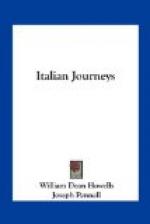We walked far down the dusty road beyond the city walls, and then struck out from the highway across the wild meadows of the Campagna. They were weedy and desolate, seamed by shaggy grass-grown ditches, and deeply pitted with holes made in search for catacombs. There was here and there a farm-house amid the wide lonesomeness, but oftener a round, hollow, roofless tomb, from which the dust and memory of the dead had long been blown away, and through the top of which—fringed and overhung with grasses, and opening like a great eye—the evening sky looked marvelously sad. One of the fields was full of grim, wide-horned cattle, and in another there were four or five buffaloes lying down and chewing their cuds,—holding their heads horizontally in the air, and with an air of gloomy wickedness which nothing could exceed in their cruel black eyes, glancing about in visible pursuit of some object to toss and gore. There were also many canebrakes, in which the wind made a mournful rustling after the sun had set in golden glitter on the roofs of the Roman churches and the transparent night had fallen upon the scene.
In all our ramble we met not a soul, and I scarcely know what it is makes this walk upon the Campagna one of my vividest recollections of Rome, unless it be the opportunity it gave me to weary myself upon that many-memoried ground as freely as if it had been a woods-pasture in Ohio. Nature, where history was so august, was perfectly simple and motherly, and did so much to make me at home, that, as the night thickened and we plunged here and there into ditches and climbed fences, and struggled, heavy-footed, back through the suburbs to the city gate, I felt as if half my boyhood had been passed upon the Campagna.
X.
Pasquino, like most other great people, is not very interesting upon close approach. There is no trace now in his aspect to show that he has ever been satirical; but the humanity that the sculptor gave him is imperishable, though he has lost all character as a public censor. The torso is at first glance nothing but a shapeless mass of stone, but the life can never die out of that which has been shaped by art to the likeness of a man, and a second look restores the lump to full possession of form and expression. For this reason I lament that statues should ever be restored except by sympathy and imagination.
XI.
Regarding the face of Pompey’s statue in the Spada Palace, I was more struck than ever with a resemblance to American politicians which I had noted in all the Roman statues. It is a type of face not now to be found in Rome, but frequent enough here, and rather in the South than in the North. Pompey was like the pictures of so many Southern Congressmen that I wondered whether race had not less to do with producing types than had similarity of circumstances; whether a republicanism based upon slavery could not so far assimilate character as to produce a common aspect in people widely separated by time and creeds, but having the same unquestioned habits of command, and the same boundless and unscrupulous ambition.




